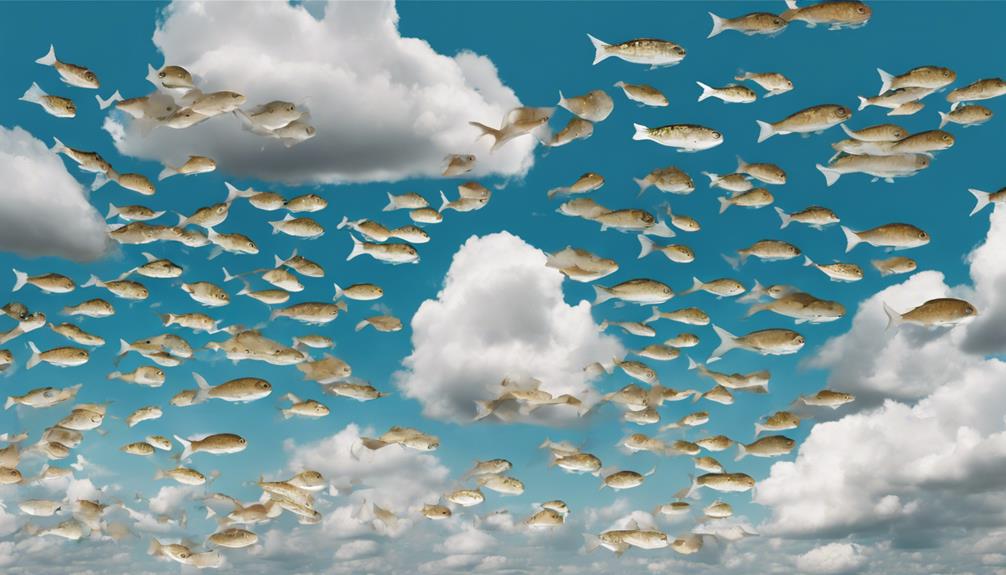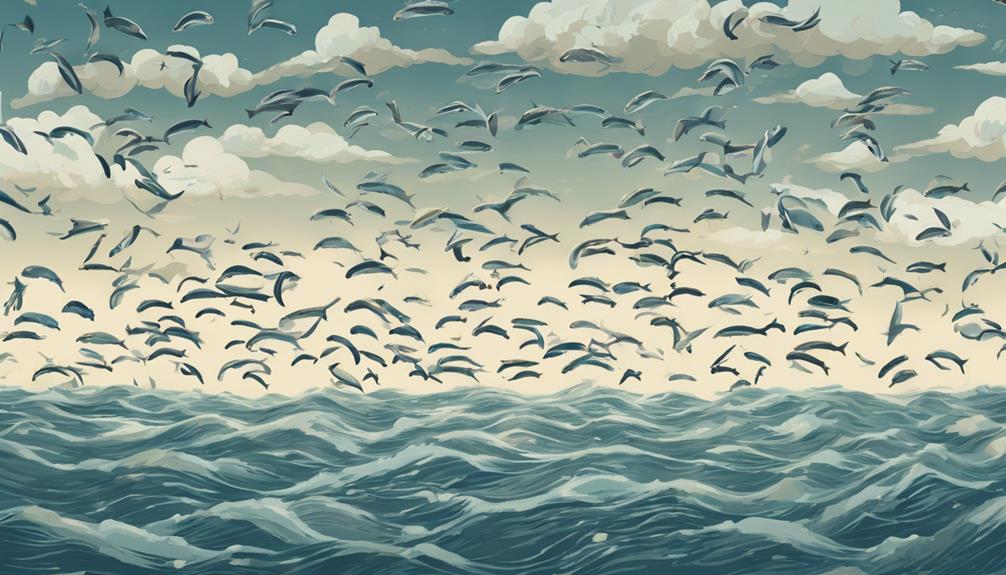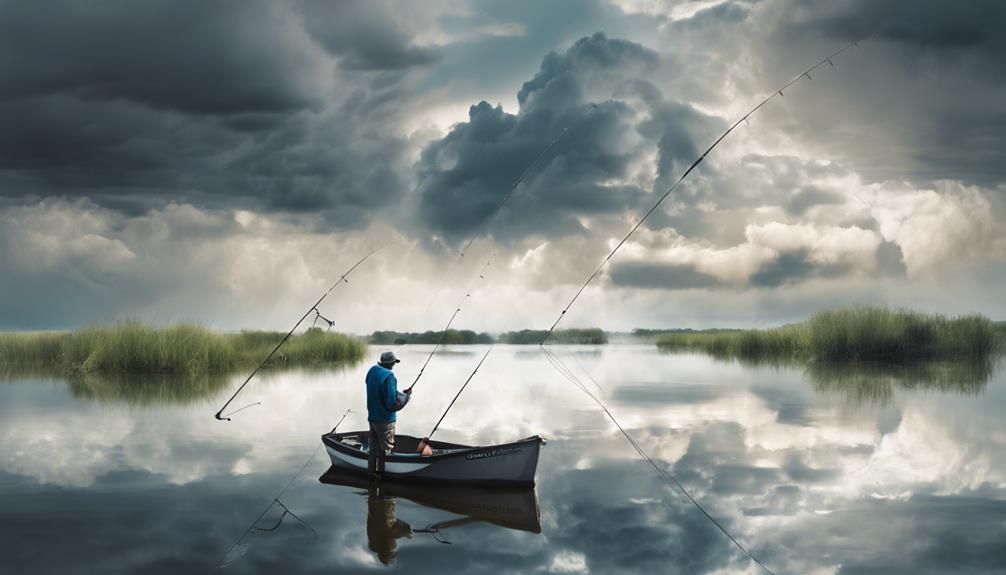Weather patterns, including temperature, wind, precipitation, barometric pressure, seasonal shifts, oceanic currents, cloud cover, and moon phases, influence fish migration significantly. Temperature changes alter fish behavior, while wind direction aids in efficient migrations. Precipitation shapes fish movements, and pressure impacts swim bladder and feeding. Seasonal shifts guide routes for survival. Oceanic currents transport eggs and larvae, and moon phases coordinate spawning events. Cloud cover affects prey distribution, and moonlit nights are utilized for migration. Weather intricately dictates fish behavior, showcasing the profound impact.
Impact of Temperature Changes
Temperature fluctuations directly influence the migratory patterns of fish species, impacting their behavior and distribution in aquatic ecosystems. Fish are highly sensitive to changes in water temperatures, as these variations play a crucial role in triggering their migration. When water temperatures shift, fish respond by adjusting their behavior to seek out optimal environments for feeding, reproduction, or shelter.
Migration patterns of fish are closely linked to water temperatures. As temperatures fluctuate, different fish species exhibit specific preferences. For example, some species, like salmon, seek colder waters for spawning, while others, such as tuna, migrate to warmer waters for feeding. These movements are driven by the need to maintain physiological functions within suitable temperature ranges.
The behavior of fish is intricately tied to temperature changes. Warmer waters can increase the metabolic rates of fish, leading to higher energy expenditures. In response, fish may alter their feeding habits, moving to shallower areas or seeking cooler depths to regulate their body temperature. Conversely, colder temperatures can slow down fish metabolism, affecting their activity levels and feeding behaviors.
Understanding how temperature fluctuations influence fish behavior is crucial for conservation efforts and fisheries management. By monitoring water temperatures and predicting fluctuations, researchers and policymakers can implement strategies to protect vulnerable fish populations and maintain the balance of aquatic ecosystems.
Role of Wind Direction
Wind direction plays a critical role in influencing the migratory behavior of fish species in aquatic environments. Wind patterns can create currents that affect the movement of fish along their migration routes. When the wind blows in the same direction as the fish's migration path, it can help them move more efficiently and cover greater distances in a shorter time. Conversely, if the wind blows perpendicular to their migration route, it can create obstacles and challenges for the fish to navigate through.
Fish often rely on wind patterns to assist them in their migrations. For instance, some species use headwinds to detect changes in water conditions or to find new feeding grounds. Additionally, tailwinds can help fish conserve energy during long migrations by providing a push in the right direction. Understanding how wind direction influences fish migration is crucial for conservation efforts and sustainable fisheries management.
Researchers have observed that certain fish species exhibit specific responses to different wind patterns. For example, some species may avoid migrating during strong winds to prevent exhaustion, while others may take advantage of favorable winds to reach their spawning grounds more quickly. By studying the relationship between wind patterns and fish behavior, scientists can gain valuable insights into the mechanisms driving these migrations and develop strategies to protect and preserve critical migration routes for fish populations.
Importance of Precipitation
In the study of fish migration patterns, an often overlooked yet significant factor to consider is the impact of precipitation on aquatic ecosystems. Rainfall distribution plays a crucial role in shaping the behavior of fish species. Different fish species exhibit varied responses to rainfall patterns, influencing their movement and migration. For instance, during periods of heavy rainfall, certain species may be more active and move towards shallow waters to take advantage of increased food availability due to runoff bringing in nutrients. On the other hand, some species may seek refuge in deeper waters to avoid the swift currents and turbidity caused by heavy rain.
Storm frequency is another key aspect of precipitation that affects fish migration. Frequent storms can lead to rapid changes in water conditions, such as temperature fluctuations and increased sedimentation, impacting the distribution of fish populations. Fish may alter their migration routes in response to these sudden environmental changes caused by storms. Additionally, intense storms can create barriers to migration, such as flooding or debris blocking traditional pathways, forcing fish to adapt their routes to reach spawning grounds or feeding areas.
Understanding the relationship between precipitation patterns and fish migration is essential for effective fisheries management and conservation efforts. By considering the influence of rainfall distribution and storm frequency on aquatic ecosystems, researchers and resource managers can develop strategies to protect vulnerable fish populations and ensure the sustainability of aquatic habitats.
Influence of Barometric Pressure
The barometric pressure directly influences the physiological behavior of fish species in aquatic environments. Fish possess specialized organs called swim bladders that help them regulate their buoyancy in the water. Changes in barometric pressure affect the swim bladder, leading to alterations in fish behavior and migration patterns.
Atmospheric conditions play a crucial role in determining the barometric pressure. When a low-pressure system approaches, fish sense the decrease in pressure and tend to move towards shallower waters. This migration is driven by the need to maintain their swim bladder's equilibrium with the changing pressure. Conversely, during high-pressure systems, fish may move to deeper waters to adjust to the increased pressure.
Pressure changes can also trigger feeding behaviors in fish. As the pressure drops, fish often become more active and feed more voraciously. This phenomenon is particularly evident in species like bass and trout, which exhibit increased feeding activity before a storm due to the associated pressure drop.
Connection to Seasonal Shifts
Have seasonal shifts been observed to influence the migratory patterns of fish in relation to weather patterns?
Seasonal shifts play a crucial role in dictating the migration routes of various fish species. As the weather changes with the seasons, fish respond by moving to different locations to optimize their chances of survival and reproduction.
During specific seasons, fish often migrate between different habitats such as freshwater rivers, oceans, or lakes. These movements are driven by the need to find suitable breeding grounds. For example, certain fish species migrate upstream in rivers during the spring to reach their spawning grounds where they can reproduce successfully. Warmer seasons are often associated with increased food availability and optimal conditions for the development of offspring, making it essential for fish to migrate to these specific areas.
Moreover, seasonal shifts can also impact the availability of resources along the migration routes. Fish may follow temperature gradients or changes in water salinity as they move between habitats. These environmental cues help guide them towards their desired breeding grounds. Understanding how seasonal shifts influence fish migration is vital for conservation efforts and sustainable fisheries management. By studying these patterns, scientists can better predict and protect the delicate balance of ecosystems that support various fish species.
Effect of Water Currents
Under the influence of water currents, fish migration patterns exhibit a dynamic response to environmental cues and navigational challenges. The speed and direction of oceanic currents play a crucial role in shaping the movements of various fish species. Here's how water currents affect fish migration:
- Current Speed: Fish often utilize water currents to assist their migration, allowing them to conserve energy by riding along with the flow.
- Temperature Variations: Oceanic currents can carry warm or cold water, influencing the distribution of fish species based on their temperature preferences.
- Feeding Opportunities: Currents can concentrate plankton and small fish in certain areas, creating feeding hotspots that attract larger predatory fish during migration.
- Spawning Behavior: Some fish species rely on specific currents to transport their eggs and larvae to suitable nursery areas, ensuring the survival of their offspring.
- Navigational Aid: Fish might use the direction of currents as a navigational aid, especially during long migrations, helping them reach their destination more efficiently.
Understanding how water currents impact fish migration is essential for conservation efforts and sustainable fisheries management. By studying these intricate relationships, researchers can better predict how changes in ocean currents due to climate change may influence fish populations in the future, highlighting the interconnected nature of marine ecosystems.
Significance of Cloud Cover

Water currents are known to influence fish migration patterns significantly, and now we shift our focus to the impact of cloud cover on this intricate ecological process. Cloud cover plays a crucial role in fish migration by affecting the amount of solar radiation reaching the water's surface. This, in turn, influences water temperature and the distribution of prey species, both of which are vital factors for fish movement.
Cloud cover acts as a natural shield, regulating the amount of solar radiation that penetrates the water. Variations in cloud cover can lead to fluctuations in water temperature, creating thermal gradients that fish use to navigate and find suitable habitats. Additionally, changes in solar radiation due to cloud cover influence the productivity of phytoplankton, a primary food source for many fish species.
Atmospheric conditions associated with cloud cover, such as air pressure and humidity, also play a role in fish migration. These conditions can impact the behavior of fish by affecting their sensory organs and overall well-being. For instance, certain fish species may exhibit changes in feeding or reproductive patterns in response to shifts in atmospheric pressure caused by cloud cover.
Relationship With Moon Phases
The correlation between fish migration patterns and moon phases is a subject of ongoing scientific inquiry due to its potential influence on nocturnal behaviors and navigational strategies. Lunar cycles play a crucial role in shaping fish behavior, with different phases of the moon impacting their activity levels and movements. Understanding this celestial influence on fish activity is essential for comprehending the intricate relationship between marine life and the lunar calendar.
- Moonlit Pathways: Fish tend to utilize moonlit nights for migration, possibly relying on the moon's brightness to navigate through the waters.
- Nocturnal Feeding Frenzy: Some species exhibit increased feeding activity during specific moon phases, suggesting a link between lunar illumination and feeding behaviors.
- Reproductive Rhythms: Moon phases may synchronize spawning events among fish populations, highlighting the profound impact of celestial bodies on their reproductive cycles.
- Tidal Triggers: The gravitational pull of the moon influences tides, affecting water currents that, in turn, can influence fish migration patterns.
- Mysterious Movements: Despite ongoing research, certain aspects of how fish perceive and respond to moon phases remain enigmatic, adding an element of intrigue to their migratory behaviors.
Through meticulous observation and data analysis, scientists continue to unravel the intricate connections between lunar cycles and fish behavior, shedding light on the mysterious ways in which celestial phenomena shape marine life.
Frequently Asked Questions
How Do Fish Migration Patterns Differ in Freshwater Versus Saltwater Environments?
In freshwater environments, fish migration patterns may be influenced by temperature fluctuations and breeding behaviors. Predation risks can also play a role, leading to adaptations in migration routes and timing.
Saltwater environments often present different challenges, with fish species adapting to varying salinity levels and ocean currents. Understanding these differences is crucial for managing and conserving fish populations in both types of habitats.
What Impact Do Natural Disasters Like Hurricanes Have on Fish Migration?
Hurricanes can significantly impact fish migration patterns.
The extreme weather conditions associated with hurricanes can disrupt fish behavior and movement.
Climate change can also play a role in altering fish migration routes as changing temperatures and ocean conditions affect their habitats.
Understanding how these natural disasters and environmental shifts influence fish migration is crucial for conservation efforts and managing fish populations effectively.
Are There Specific Fish Species That Are More Sensitive to Weather Changes?
Certain fish species exhibit varying degrees of sensitivity to weather changes. Climate adaptation plays a crucial role in how different species respond to shifts in temperature and environmental conditions.
Factors such as temperature tolerance levels, habitat preferences, and migratory patterns all influence the ability of fish to adapt to changing weather patterns. Understanding these dynamics is essential for predicting how fish populations may be impacted by future climate fluctuations.
How Do Artificial Structures Like Dams Affect Fish Migration Routes?
When it comes to fish migration routes, artificial structures like dams can have significant impacts on fish behavior. These man-made obstacles can alter the natural flow of rivers, disrupting the traditional pathways that fish follow during migration.
Dams can create physical barriers that impede fish movement, leading to challenges in reaching spawning grounds or accessing vital feeding areas. Understanding how these structures affect fish migration is crucial for conservation efforts and ecosystem management.
Can Extreme Weather Events Disrupt Regular Fish Migration Patterns?
Extreme weather events, influenced by climate change, can indeed disrupt regular fish migration patterns. These disruptions can lead to alterations in migration routes, affecting the timing and success of fish movement.
Sudden changes in water temperature, flow rates, and oxygen levels can all impact the ability of fish to navigate their traditional migration paths. Understanding these disruptions is crucial for managing and conserving fish populations in the face of changing environmental conditions.
Conclusion
In conclusion, understanding how weather patterns dictate fish migration is essential for successful fishing endeavors.
Temperature changes, wind direction, precipitation, barometric pressure, seasonal shifts, water currents, cloud cover, and moon phases all play a crucial role in influencing the movement of fish populations.
By closely monitoring these factors, anglers can significantly improve their chances of locating and catching fish in different environments and conditions.
It's a complex interplay of natural elements that ultimately determines fish behavior and migration patterns.



